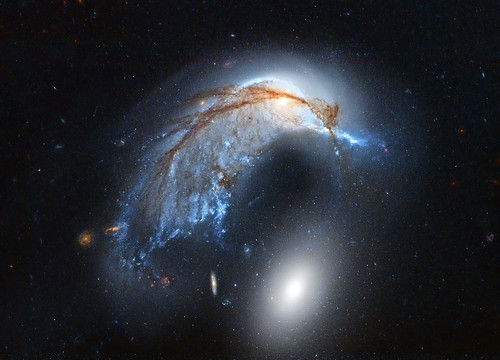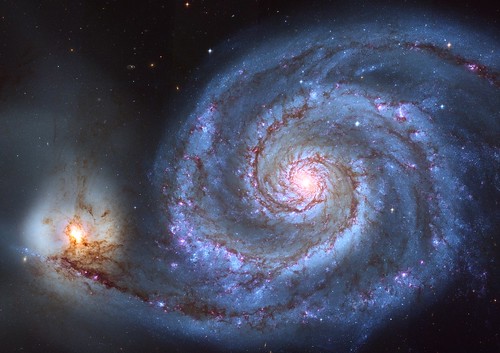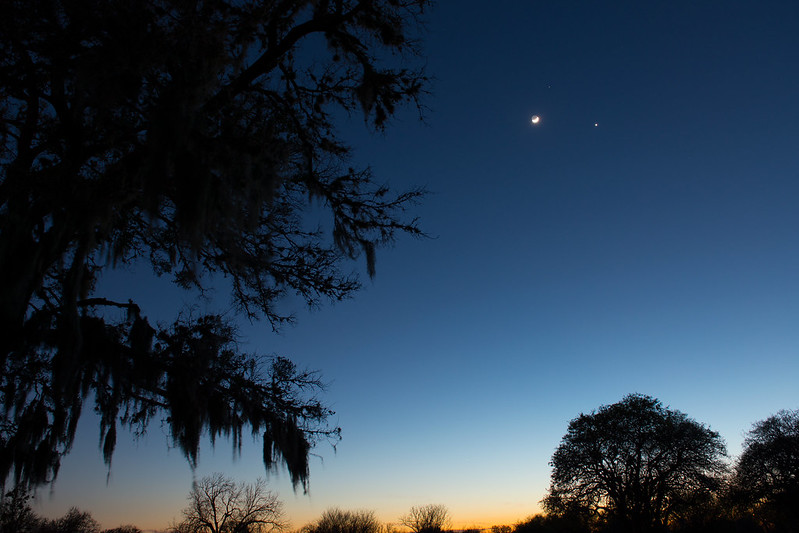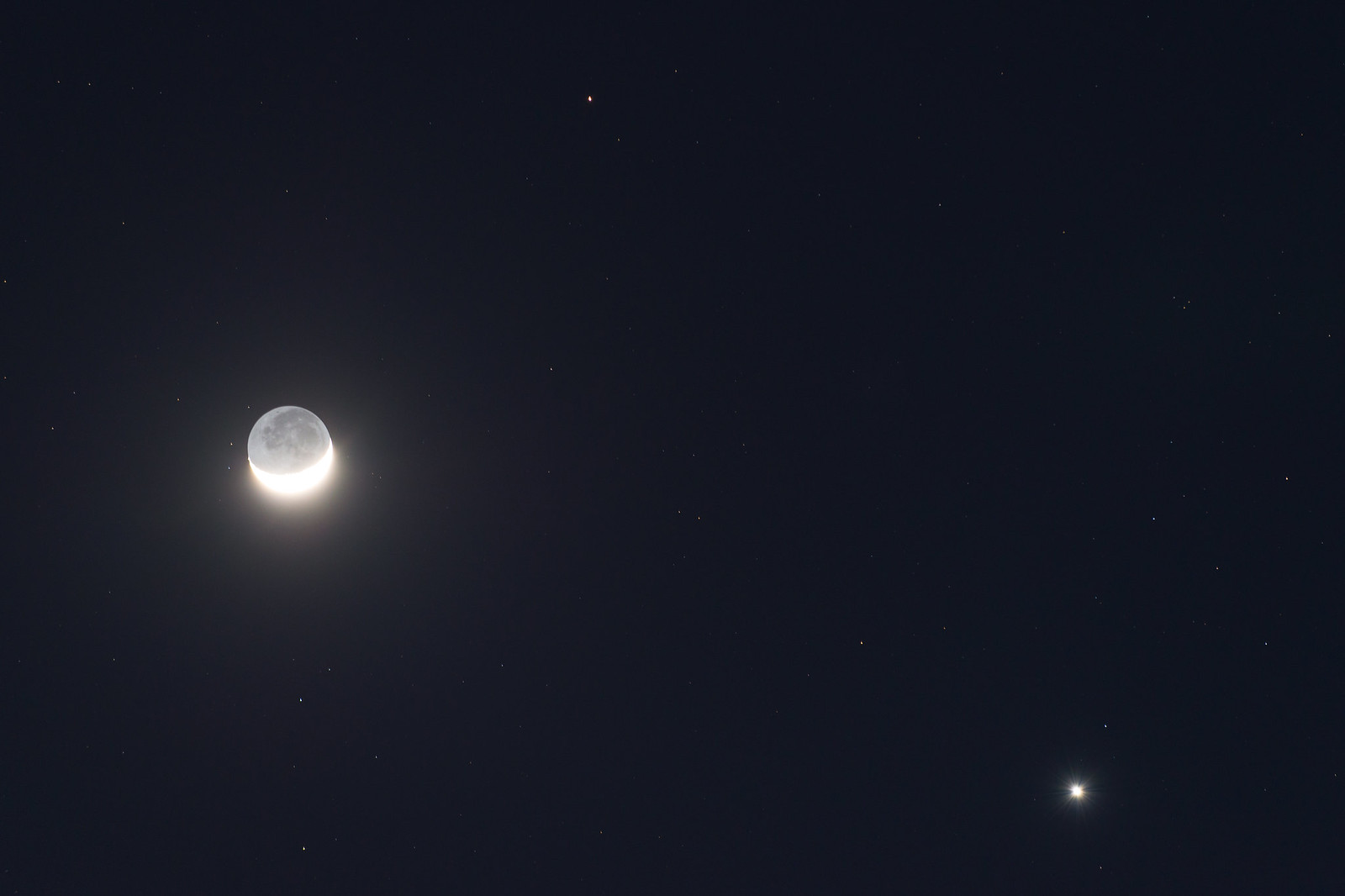Submissions: 2017 January
-
Stefan Westphal
- Ensign
- Posts: 40
- Joined: Sun Jan 12, 2014 4:24 pm
Re: Submissions: 2017 January
Heart and Soul Nebula
Copyright: Stefan Westphal
61x5min/ ISO 800/ Canon 5dMKII/ EF 300 f4
Copyright: Stefan Westphal
61x5min/ ISO 800/ Canon 5dMKII/ EF 300 f4
Re: Submissions: 2017 January
The Frog nebula - AKA Barnard 163
In Ha-RGB and only in Ha
Larger versions:
http://www.pbase.com/tango33/new_images
Thanks for looking!
Kfir Simon


In Ha-RGB and only in Ha
Larger versions:
http://www.pbase.com/tango33/new_images
Thanks for looking!
Kfir Simon


-
samuelegasparini
- Ensign
- Posts: 15
- Joined: Tue Nov 19, 2013 8:17 pm
- Location: Castelfiorentino (Italy)
- Contact:
Re: Submissions: 2017 January
Ic 434 "Horse Head Nebula"
Refractor Apo Ts Photoline 80mm with 0.80X reducer and flattener
Ccd Atik 383L+ -14° in binning 1x1
Exp di 4h con sub frames di 900 sec in HAlpha channel + 120 min for LRGB channels
Samuele Gasparini Castelfiorentino (Fi) website: http://www.astrobook.it
Explanation from Wikipedia: The Horsehead Nebula (also known as Barnard 33) is a dark nebula in the constellation Orion.[1] The nebula is located just to the south of the star Alnitak, which is farthest east on Orion's Belt, and is part of the much larger Orion Molecular Cloud Complex. The nebula was first recorded in 1888 by Scottish astronomer Williamina Fleming on photographic plate B2312 taken at the Harvard College Observatory.[2] The Horsehead Nebula is approximately 1500 light years from Earth. It is one of the most identifiable nebulae because of the shape of its swirling cloud of dark dust and gases, which bears some resemblance to a horse's head when viewed from Earth.
Refractor Apo Ts Photoline 80mm with 0.80X reducer and flattener
Ccd Atik 383L+ -14° in binning 1x1
Exp di 4h con sub frames di 900 sec in HAlpha channel + 120 min for LRGB channels
Samuele Gasparini Castelfiorentino (Fi) website: http://www.astrobook.it
Explanation from Wikipedia: The Horsehead Nebula (also known as Barnard 33) is a dark nebula in the constellation Orion.[1] The nebula is located just to the south of the star Alnitak, which is farthest east on Orion's Belt, and is part of the much larger Orion Molecular Cloud Complex. The nebula was first recorded in 1888 by Scottish astronomer Williamina Fleming on photographic plate B2312 taken at the Harvard College Observatory.[2] The Horsehead Nebula is approximately 1500 light years from Earth. It is one of the most identifiable nebulae because of the shape of its swirling cloud of dark dust and gases, which bears some resemblance to a horse's head when viewed from Earth.
Re: Submissions: 2017 January
Rosette Nebula
Gso 200/800 F4 with baader coma corrector
Ccd Atik 383L+mono
Skywatcher Az-Eq6 GT
Baader narrowband filters
halfa -20 15x600s binning 1x1
olll -15 10x300s binning 2x2
sll -15 10x300s binning 2x2
Qhy5 guider with 50mm finder scope
The Rosette Nebula (also known as Caldwell 49) is a large, spherical (circular in appearance), H II region located near one end of a giant molecular cloud in the Monoceros region of the Milky Way Galaxy. The open cluster NGC 2244 (Caldwell 50) is closely associated with the nebulosity, the stars of the cluster having been formed from the nebula's matter.
The cluster and nebula lie at a distance of some 5,000 light-years from Earth and measure roughly 50 light years in diameter. The radiation from the young stars excites the atoms in the nebula, causing them to emit radiation themselves producing the emission nebula we see. The mass of the nebula is estimated to be around 10,000 solar masses.
Rosette nebula
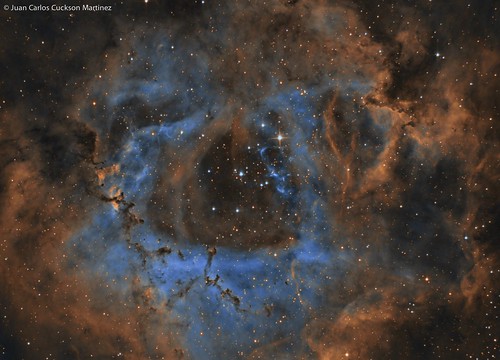 Rosette nebula by Juan Carlos Cuckson, en Flickr
Rosette nebula by Juan Carlos Cuckson, en Flickr
Copyright: Juan Carlos Cuckson Martinez
Gso 200/800 F4 with baader coma corrector
Ccd Atik 383L+mono
Skywatcher Az-Eq6 GT
Baader narrowband filters
halfa -20 15x600s binning 1x1
olll -15 10x300s binning 2x2
sll -15 10x300s binning 2x2
Qhy5 guider with 50mm finder scope
The Rosette Nebula (also known as Caldwell 49) is a large, spherical (circular in appearance), H II region located near one end of a giant molecular cloud in the Monoceros region of the Milky Way Galaxy. The open cluster NGC 2244 (Caldwell 50) is closely associated with the nebulosity, the stars of the cluster having been formed from the nebula's matter.
The cluster and nebula lie at a distance of some 5,000 light-years from Earth and measure roughly 50 light years in diameter. The radiation from the young stars excites the atoms in the nebula, causing them to emit radiation themselves producing the emission nebula we see. The mass of the nebula is estimated to be around 10,000 solar masses.
Rosette nebula
 Rosette nebula by Juan Carlos Cuckson, en Flickr
Rosette nebula by Juan Carlos Cuckson, en FlickrCopyright: Juan Carlos Cuckson Martinez
Last edited by Juanky on Sun Jan 29, 2017 3:38 pm, edited 3 times in total.
-
Zhuoxiao Wang
- Ensign
- Posts: 15
- Joined: Fri Oct 10, 2014 1:58 pm
Re: Submissions: 2017 January
The one day phase crescent moon setting into Pacific Ocean.
We can see the magnificent atmospheric refraction when the moon setting down. As moon close to the horizon, it gets flatter and distorted by inversion layer, especially the last one.
We can see the magnificent atmospheric refraction when the moon setting down. As moon close to the horizon, it gets flatter and distorted by inversion layer, especially the last one.
Zhuoxiao Wang
PhD candidate in Astrophysics, Tsinghua Univ. , China
E-mail: zhuoxiaowang[at]gmail.com
PhD candidate in Astrophysics, Tsinghua Univ. , China
E-mail: zhuoxiaowang[at]gmail.com
-
Zhuoxiao Wang
- Ensign
- Posts: 15
- Joined: Fri Oct 10, 2014 1:58 pm
Re: Submissions: 2017 January
The wave like sculpture is in the University of California, Santa Cruz, known as 'the Squiggle'.
Looking into this startrails photos, one trail below sculpture, is surprisingly the second brightest star in the whole night sky, Canopus. It's located at -52°42′ declination and rises up no more than 1 degree above the horizon even with the help of atmosphere refraction.
Here we have a glimpse of Canopus at 37 degrees Northern Latitude, and the extremely low altitude also distorted the trails at the end part.
Looking into this startrails photos, one trail below sculpture, is surprisingly the second brightest star in the whole night sky, Canopus. It's located at -52°42′ declination and rises up no more than 1 degree above the horizon even with the help of atmosphere refraction.
Here we have a glimpse of Canopus at 37 degrees Northern Latitude, and the extremely low altitude also distorted the trails at the end part.
Zhuoxiao Wang
PhD candidate in Astrophysics, Tsinghua Univ. , China
E-mail: zhuoxiaowang[at]gmail.com
PhD candidate in Astrophysics, Tsinghua Univ. , China
E-mail: zhuoxiaowang[at]gmail.com
-
jerry10137
- Ensign
- Posts: 13
- Joined: Thu Nov 07, 2013 3:30 am
Mellote 15
Copyright Jerry Gardner
HaRGB
20xHa@600 sec
20xR@600 sec
20xG@600 sec
20xB@600 sec
http://www.keith-engineering.com/pictur ... aRBG_2.jpg
http://www.theconstellationranch.com
HaRGB
20xHa@600 sec
20xR@600 sec
20xG@600 sec
20xB@600 sec
http://www.keith-engineering.com/pictur ... aRBG_2.jpg
http://www.theconstellationranch.com
Last edited by bystander on Mon Jan 30, 2017 7:04 am, edited 1 time in total.
Reason: Please, no hotlinks to images > 500Kb.
Reason: Please, no hotlinks to images > 500Kb.
Re: Submissions: 2017 January
Pleaides Star Cluster
Total of 3h10min (38x300s) at ISO800
TS80 Triplet Apo
Canon 1000Da
NEQ6 Pro II Tuning
Autoguide with ASI120MC
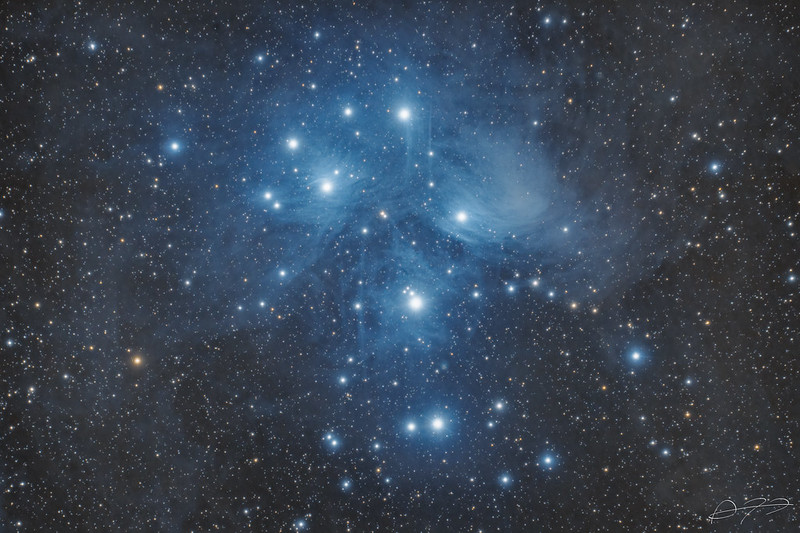 Pleiades - M45 by Alejandro Pertuz, en Flickr
Pleiades - M45 by Alejandro Pertuz, en Flickr
Total of 3h10min (38x300s) at ISO800
TS80 Triplet Apo
Canon 1000Da
NEQ6 Pro II Tuning
Autoguide with ASI120MC
 Pleiades - M45 by Alejandro Pertuz, en Flickr
Pleiades - M45 by Alejandro Pertuz, en FlickrRe: Submissions: 2017 January
SHII 136 - A Spooky Nebula
Copyright: CAAT - Centro Astronómico del Alto Turia - Gonzalo Fornas
Processing: Laureano Martín - Alfonso Carreño Best Regards.-)
Copyright: CAAT - Centro Astronómico del Alto Turia - Gonzalo Fornas
Processing: Laureano Martín - Alfonso Carreño Best Regards.-)
-
Efrain Morales
- Commander
- Posts: 508
- Joined: Fri Oct 22, 2010 8:15 pm
- AKA: Jaicoa
- Location: Aguadilla, Puerto Rico
- Contact:
Jupiter-GRS,Oval Ba, SEB Disturbance
Jupiter, GRS, Oval Ba and South Equatorial Belt zone disturbance on 2017-01-29-0938ut. LX200ACF 12 in OTA, CGE Mount, ASI290mm Ccd, PowerMate 2.5x Barlows, Custom Scientific RGB filters.
Re: Submissions: 2017 January
Triple conjunction over Gran Sasso mountain - Abruzzo, Italy
http://www.giovannidifabio.com
Copyright: Giovanni Di Fabio
http://www.giovannidifabio.com
Copyright: Giovanni Di Fabio
-
Deep-Sky-Astroteam
- Ensign
- Posts: 54
- Joined: Tue Aug 26, 2014 9:01 am
- Location: Berlin - Germany
- Contact:
Re: Submissions: 2017 January
SH2-261 Lowers Nebula
Copyrights: Frank Iwaszkiewicz FullRes: https://www.deep-sky-astroteam.de/de/node/406
Copyrights: Frank Iwaszkiewicz FullRes: https://www.deep-sky-astroteam.de/de/node/406
-
mdieterich
- Science Officer
- Posts: 100
- Joined: Fri Feb 13, 2015 5:50 pm
Re: Submissions: 2017 January
Moon, Venus, and Mars conjuction January 31st, 2017 from Victoria, Texas.
Moon, Venus, and Mars Conjunction
URL of website, http://www.mdieterichphoto.com
Copyright: Matt Dieterich https://c1.staticflickr.com/1/436/32261 ... 292a_h.jpg
Moon, Venus, and Mars Conjunction
URL of website, http://www.mdieterichphoto.com
Copyright: Matt Dieterich https://c1.staticflickr.com/1/436/32261 ... 292a_h.jpg
Last edited by bystander on Wed Feb 01, 2017 5:46 am, edited 1 time in total.
Reason: Please, no hotlinks to images > 500Kb. Substituted smaller image.
Reason: Please, no hotlinks to images > 500Kb. Substituted smaller image.
-
mdieterich
- Science Officer
- Posts: 100
- Joined: Fri Feb 13, 2015 5:50 pm
Re: Submissions: 2017 January
On the night of January 31st, the Moon passed within 2 degrees of Mars (top center) while joining Venus in the night sky.
Conjunction
URL of website, http://www.mdieterichphoto.com
Copyright: Matt Dieterich
Conjunction
URL of website, http://www.mdieterichphoto.com
Copyright: Matt Dieterich
-
Mauro Rorato
- Ensign
- Posts: 15
- Joined: Tue Jan 20, 2015 9:07 am
Re: Submissions: 2017 January

http://themaurosky.wixsite.com/astrophotography/m37
Messier 37 (also known as M37 or NGC 2099) is the richest open cluster in the constellation Auriga , It is the brightest of three open clusters in Auriga.
M37 is located in the antipodal direction, opposite from the Galactic Center as seen from Earth.[4] Estimates of its age range from 347[1] million to 550[3] million years.
It has 1,500[2] times the mass of the Sun and contains over 500 identified stars,[3] with roughly 150 stars brighter than magnitude 12.5. M37 has at least a dozen red giants and its hottest surviving main sequence star is of stellar classification B9 V. The abundance of elements other than hydrogen and helium, what astronomers term metallicity, is similar to, if not slightly higher than, the abundance in the Sun.[1]
At its estimated distance of around 4,500 light-years (1,400 parsecs)[1] from Earth, the cluster's angular diameter of 24 arcminutes corresponds to a physical extent of about 20–25 ly (6.1–7.7 pc).
-
astropaddy
- Ensign
- Posts: 28
- Joined: Sat Jan 10, 2015 11:54 pm
Re: Submissions: 2017 January
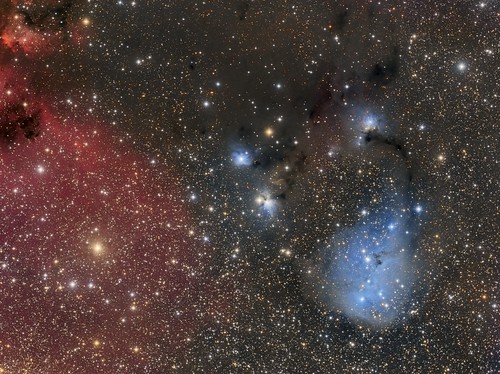 IC 447/446/2169 + NGC 2247/2245 - The Blue Tadpole? by Patrick Gilliland, on Flickr
IC 447/446/2169 + NGC 2247/2245 - The Blue Tadpole? by Patrick Gilliland, on FlickrHere we have a look at the IC 447/6 areas - nice feature packed area of the sky. Not seen too often either.
© Paddy Gilliland 2017
-
astropaddy
- Ensign
- Posts: 28
- Joined: Sat Jan 10, 2015 11:54 pm
Re: Submissions: 2017 January
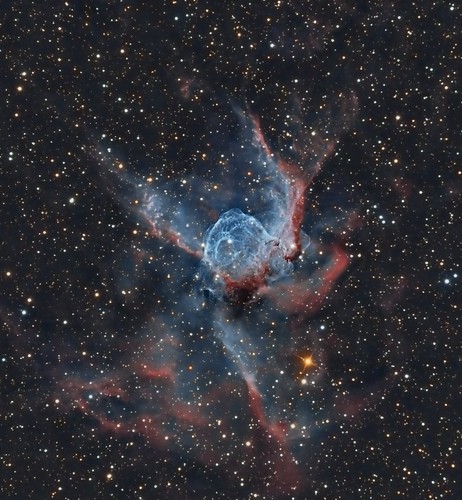 Thors Helmet - NGC 2359 by Patrick Gilliland, on Flickr
Thors Helmet - NGC 2359 by Patrick Gilliland, on FlickrA winter favorite - NGC 2359 Thor's Helmet.
© Paddy Gilliland 2017
